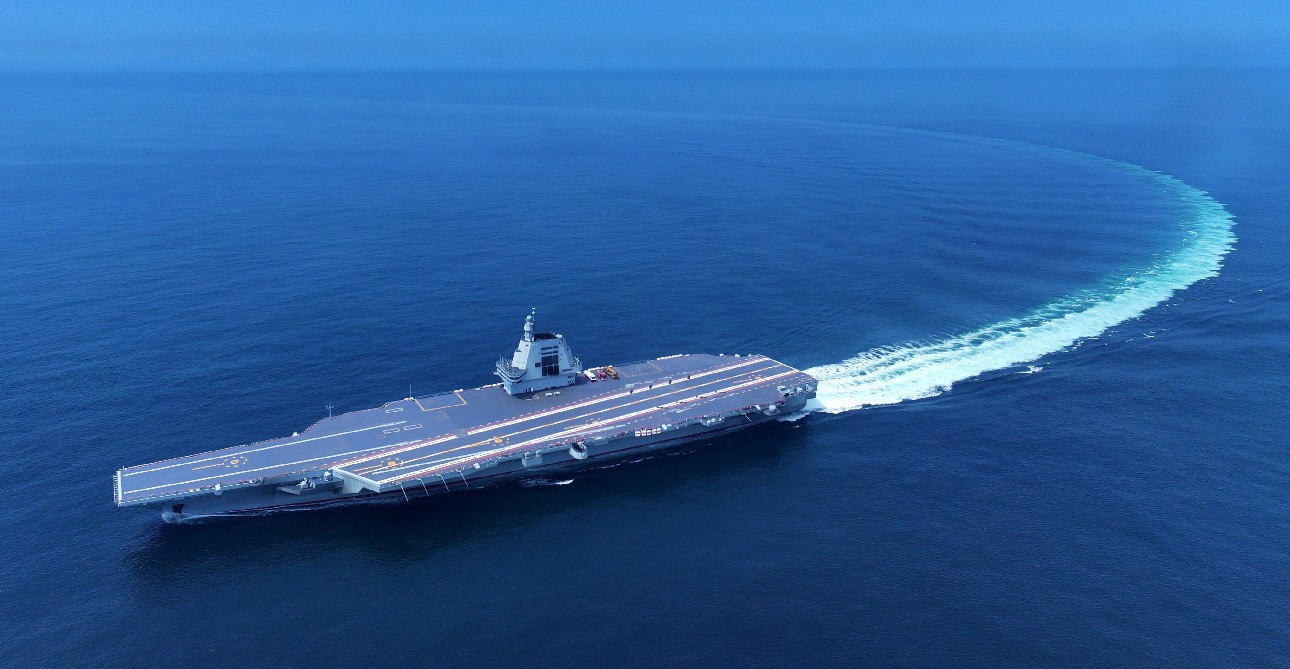Reports have emerged of China’s secret construction of the world’s first dedicated drone carrier, highlighting the nation’s groundbreaking stride in naval warfare.
India To Counter China’s Fujian With 3rd Aircraft Carrier; Defense Minister Says ‘Work On’ For Third Carrier
The vessel, resembling a compact aircraft carrier, was spotted through satellite images dated May 6, Naval News reported. The ship is situated discreetly in a shipyard on the Yangtze River, away from the bustling maritime hubs of Shanghai.
The revelation, corroborated by insights from J. Michael Dahm, a distinguished resident fellow specializing in aerospace and China studies at the Mitchell Institute in the US, signals China’s strategic foresight in harnessing unmanned aerial technologies for maritime operations.
Comparatively smaller than conventional aircraft carriers, this ship boasts a flight deck approximately one-third the length and half the width of its counterparts in the US Navy or the Chinese People’s Liberation Army Navy (PLAN).
Its dimensions, notably shorter than those of China’s amphibious assault ships, which primarily deploy manned helicopters, suggest a deliberate adaptation to accommodate fewer helicopters or smaller aerial platforms, such as drones.
***BREAKING***#China has built the world’s first dedicated drone carrier. It’s about the size of escort carriers of World War Two. #OSINThttps://t.co/nmUpdqO3YX
— H I Sutton (@CovertShores) May 15, 2024
Although capable of facilitating fixed-wing aircraft operations, its linear deck configuration poses operational challenges, precluding simultaneous take-off and landing — a feature commonplace on modern carriers.
However, the report indicates that the flight deck’s width is suitable for aircraft or drones with a wingspan of approximately 65 feet, akin to the Chinese equivalent of the Reaper drone.
The absence of a hangar below the flight deck for aircraft storage and maintenance indicates a departure from traditional carrier design. The lack of such space suggests a limitation on the number of aircraft the vessel can accommodate, raising questions about its operational capacity.
Despite scant details surrounding the vessel, speculation among experts suggests the vessel might serve as yet another experimental platform for China’s burgeoning naval capabilities.
The absence of a hangar and limited space for aircraft suggests a primary focus on trial and innovation rather than immediate operational deployment.
Drones typically operate within a limited range, restricting their deployment away from coastal regions. The acquisition of a carrier, therefore, would provide the Chinese navy with a more extensive and resilient network, enabling various types of drones to conduct attacks effectively.

The Emergence Of Drone Carriers
In the ever-evolving landscape of modern warfare, drones have emerged as formidable assets, offering unparalleled versatility and efficiency across various military domains. As navies worldwide seek advanced capabilities and strategic advantages, the integration of drones into maritime operations has become a prominent focus.
China, renowned for its rapid technological advancements, made waves in 2022 with the launch of the Zhu Hai Yun, an unmanned ship touted for its remote-control capabilities and autonomous navigation prowess.
Although officially designated for oceanic research, experts have raised concerns about its potential military applications, underscoring China’s strategic ambitions in the maritime domain.
Meanwhile, Turkey’s foray into drone carrier technology has culminated in the commissioning of the TCG Anadolu (L-400) in April 2023.
Initially designed to house various aircraft, including drones, helicopters, and the Lockheed Martin F-35, the vessel had to be modified following Turkey’s purchase of the Russian S-400 air defense system, which resulted in its removal from the F-35 program.

The carrier was repurposed as a platform exclusively for helicopters and drones, aligning with Turkey’s growing drone development initiatives. Plans for a sister ship, TCG Trakya, further signify Turkey’s commitment to bolstering its naval capabilities.
Iran, too, has joined the race, with reports first emerging in 2023 of the Iranian Revolutionary Guard Corps (IRGC) Navy converting the Shahid Mahdavi, a former container ship, into a drone carrier. The vessel is currently in active service with the Iranian Revolutionary Guard Corps.
Armed with advanced technology, including cutting-edge radar systems and missile defense capabilities, the Shahid Mahdavi is poised to become a crucial asset in Iran’s maritime arsenal.
Designed to deploy helicopters and runway-launched fixed-wing drones, such as the notorious Shahed-136 kamikaze drones, the carrier represents Iran’s assertive stance in unmanned warfare.
Further, rumors abound of the impending addition of another drone carrier, the Shahid Bagheri, to Iran’s naval fleet. If that happens, it signals Tehran’s sustained investment in drone capabilities.
- Contact the author at ashishmichel(at)gmail.com
- Follow EurAsian Times on Google News




